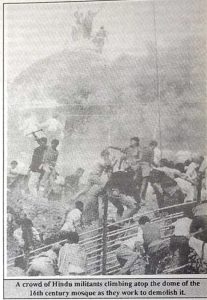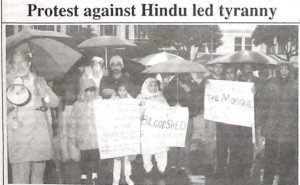NEW DELHI: In fast moving development Indias Hindu fundamentalists demolished the 430year-old Babri Masjid at Ayodhia in UP. Hindu security forces killed hundreds of Muslim protesters all over the country while the 50-nation strong organization of Muslim countries led the worldwide reaction against the Indian developments.
The tragic drama began on Dec.6 at Ayodhia where more than 2 lakh Hindu fundamentalists had converged from all over India to begin construction of a temple at the call of Vishva Hindu Parishad. The V.H.P had invited Hindus more than a month ago for the scheduled voluntary construction work. Even in Indias intelligence agencies reportedly sent alarming. reports about the fundamentalists” plan to destroy the Muslim shrine the Indian central government headed by prime minister Narasimha Rao passed the buck to the country’s supreme court to prevent the threat.
According to correspondents who were present to witness the Ayodhya scheme the Hindu fundamentalists had a free hand to demolish the shrine The U.P. police which was in position at the site had only sticks to prevent the threatened onslaught on the masjid As soon as the first attackers moved forward at about 2:30 p.m. on Dec.6 to scale the domes of the Babri structure the security forces withdrew leaving the field free for the demolition squads. The vandalism continued for more than five hours until dusk. By then the entire structure had come down crashing. In the process at least four “kar sevaks” died.
It was only when the aim was achieved by Hindu fundamentalists the U.P. state ministry headed by B.J.P.s Kalyan Singh sent in its resignation to states governor. India’s central government had sent thousands of its forces to Ayodhya a few days prior to the scheduled dead-line but no orders came from Delhi to them to intervene and stop the masjid demolition It was only at the end of the operation demolition that the central Indian government announced dismissal of the Kalyan Singh government rather than accepting its resignation. But still no orders were given to the central forces to take control of the disputed mandir-masjid site and the fundamentalists merrily continued with the Mandir construction work at the site of the demolished masjid. The forces took control of the place only after 48 hours of the demolition to give ample time to the fundamentalists to lay the foundations of the proposed Hindu shrine.
The Hindu fundamentalists ensured that journalists did not get photographs of the demolition process. Consequently numerous journalists were beaten up and their cameras were snatched away by the kar sewaks. Even foreign journalists of respected publications had to suffer multiple injuries. The journalists later met at Delhi and organized a protest march.
Meanwhile Muslims and other minority groups of India issued strongly-worded statements condemning the central government for its complicity in the Ayodhya developments. Lakhs of Muslims organized protest rallies all over the country. Trouble spread to more than a dozen Indian states. Army was called out in several states to suppress Muslim protest demonstrations resulting in more than 350 deaths in the first two days of protests.
Among the affected centers were Bombay and several districts of Marathwada in Maharashwa Bidar in Kamataka Jaipur in Rajasthan Bhopal in Madhya Pradesh Ahmadabad in Gujarat and 22 towns of 14 districts in U.P. There were pitched battles between Muslim youths and the police in Delhi resulting in 12 injured. The trouble extended to Kerala West Bengal Assam and Bihar. More than 100 Muslims were killed in police firings in Maharashtra alone according to reports. Curfew was imposed in hundreds of towns.
The national front and the leftist front organized a one-day strike in India on Dec.8 while the leftist government of west Bengal encouraged a three-day strike action in that state to protest against the Ayodhia demolition Evidently these parties have Muslim votes in view while they join hands with Muslims on the issue.
The Muslim protest movement its spread and intensity have surprised political observers here Never before had Muslim masses acted on a common cause as they did on the Babri issue. Evidently this combined reaction encouraged the Pakistan government and politicians in that country not only to see vindication of the formation of Pakistan and the two-nation theory in India’s developments but also to raise the demand for an independent Muslim country on Indian mainland.
Muslim members of Indian parliament cutting across political parties are one in condemning the role of Prime Minister Narasimha Rao in at the Ayodhya tragedy. The Indian Union Muslim League which has been supporting the Rao government is in revolt reducing the central government again in a minority. While the thrust of criticism of the national front leftist combine is on BJP and its allies the Muslim opinion is definitely equally against the Rao government.
For two days the non-B.J.P. opposition parties in Indian parliament mounted attacks on the Rao government’s handling of the Ayodhya issue. They did not allow any business of the two houses of Indian parliament to be transacted. They kept up the refrain of seeking the resignation of Prime Minister Rao.
Pressure was also mounting on the prime minister either to adopt tough posture towards the V.H.P. R.S.S. combine or bow out Raos rivals such as human resources minister Arjun Singh and defence minister Sharad Pawar are said to be mobilizing support for change at the highest level In any case the days of the Indian home minister Chavan are numbered.
In an effort at survival in view of the Muslim protest movement in India and abroad Narasimha Rao is trying a way out of the situation. BJ.P. chief Murli Manohar Joshi and senior leader Krishan Dal Advani as also the V.H.P. chief Singhal were arrested on Dec.8. There was also talk of a ban being imposed on certain Hindu fundamentalist organizations such as V.HP. R.S.S. and Bajrang Dal. But there is no certainty on that count because these organizations have vast reservoir of support and sympathy among India’s bureaucracy and armed forces. In any case there will be enough loopholes in law for the banned organizations to survive the present backlash.
The government also talked in terms of rebuilding the Babni masjid but its precise location which is in the center of the controversy is not being indicated.



Article extracted from this publication >> December 18, 1992